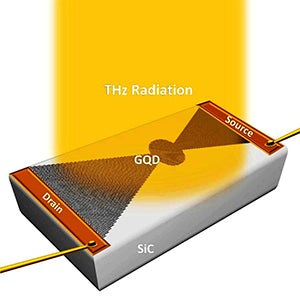Georgetown Researchers Develop New Ultrasensitive Nanodevice
 January 7, 2016—A team of researchers from Georgetown University and the Naval Research Laboratory (NRL) have found a new way to detect millimeter-wavelength radiation with 100,000 times more sensitive than conventional technology. Georgetown College Associate Professor of Physics Paola Barbara and her team published their findings in the latest issue of Nature Nanotechnology, a multidisciplinary journal dedicated to nanoscience and nanotechnology.
January 7, 2016—A team of researchers from Georgetown University and the Naval Research Laboratory (NRL) have found a new way to detect millimeter-wavelength radiation with 100,000 times more sensitive than conventional technology. Georgetown College Associate Professor of Physics Paola Barbara and her team published their findings in the latest issue of Nature Nanotechnology, a multidisciplinary journal dedicated to nanoscience and nanotechnology.
Terahertz radiation has wavelengths ranging from tens of micrometers to a few millimeters and is not visible to the human eye. Although it is difficult to detect, terahertz radiation can penetrate skin, muscles, and teeth to provide information on abnormalities in humans and animals. “There are not many detectors or powerful sources for terahertz. This type of radiation can be used for applications in many fields, from medical or security imaging (it can penetrate most nonconducting materials like clothing or plastic, without the damaging ionization effects of x-rays) to spectroscopy (it can be used to identify the chemical composition of compounds),” Barbara said.
To see this radiation, scientists use a tool called a bolometer. Barbara and Dr. Abdel El Fatimy, a postdoctoral fellow at Georgetown, worked in collaboration with Dr. Kurt Gaskill’s group at NRL to create a bolometer using small area devices known as quantum dots. The dots are made from graphene, a two-dimensional form of carbon that is one atomic layer thick and has “extraordinary electronic and optical properties,” Barbara explained. The dots have dimensions 500 times smaller than the width of a human hair (or less than a tenth of a micrometer) and have extraordinarily high sensitivity to two-millimeter wavelength radiation.
Starting with high-quality graphene grown at NRL, the quantum dots were produced using standard semiconductor device processing techniques at the Georgetown Nanoscience and Microtechnology Laboratory (GNμLab), a state-of-the-art facility in Regents Hall. “This [production method] means it is possible to integrate antennas to the quantum-dot detector using straightforward methods,” said Gaskill, who leads a research group at NRL. “The addition of an antenna will further improve the sensitivity of the quantum-dot detectors,” he continued. Because the graphene is uniform, many individual detectors or arrays of detectors with similar properties can be fabricated at one time.
“The ability to make materials that are just one atom thick and to build electronic devices with them presents new opportunities,” Barbara continued. “Graphene quantum dots were studied before, but never as bolometers. Their extraordinary performance and ease of fabrication are a technological breakthrough.”
Related Information
The article, “Epitaxial graphene quantum dots for high-performance terahertz bolometers,” was published in the latest issue of Nature Nanotechnology. The authors are Abdel El Fatimy, Rachael L. Myers-Ward, Anthony K. Boyd, Kevin M. Daniels, D. Kurt Gaskill, and Paola Barbara. The study was developed with funding from the Office of Naval Research and the Air Force Office of Scientific Research.
Image: The artist’s impression shows a graphene layer patterned with a circular quantum dot in the center. The graphene is exposed to terahertz radiation and connected to electrical contacts to measure the electrical output signal. (Image courtesy of Abdel El Fatimy and Oliver Albertini.)
- Tagged
- Faculty